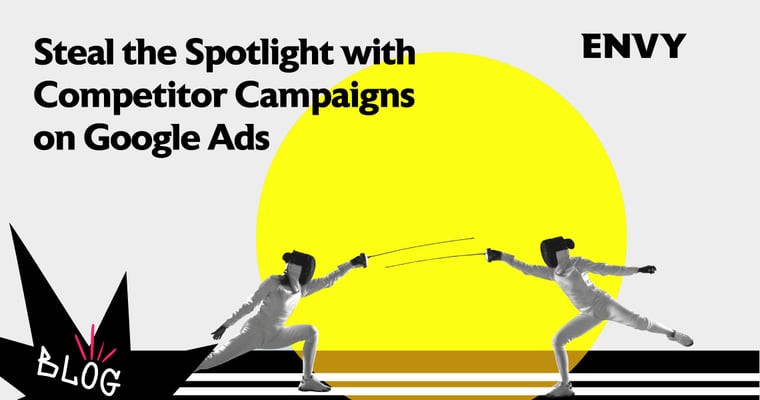
Steal the Spotlight with Competitor Campaigns on Google Ads
Probably the most controversial of all paid campaigns, competitor campaigns on Google Ads can either bring you high intent leads or have you waste extra dollars and spend even more on your own brand. The outcome, of course, relies greatly on how you run them.
We’ve jotted down some tips and tricks on how to make the most out of your competitor campaign on Google Ads. With the right strategy and approach, you can turn your competitors' audience into yours.
Hold on a sec, why would I want to run a competitor campaign?
The idea behind competitor campaigns is simple: intentionally show your Google Ads to your competitor's audience by intercepting the search traffic that's already looking for your competitors. Why? Because those searchers are likely in need of a specific product or service that might as well be yours. Maybe they don’t even know you offer something better suited to their needs? So you bid on your competitor's branded keywords, which can drive traffic away from their site and towards your own. By doing so, you can capture a piece of the market and expose potential customers to your brand.
Example of a competitor campaign: Searching for Clickup, showing Monday.com
Competitor campaigns on Google Ads: pros & cons
When planned and executed right, bidding on your competitors’ brand names will boost your visibility and help attract higher intent leads. There’s even more to it:
Pros of competitor campaigns
- Higher intent leads - the target audience is searching for a solution or service that your competitor is providing. If you manage to intercept, you’re gaining a lead that is already MoF and will likely convert to being an SQL or opportunity more quickly.
- New audience - With competitor campaigns, you can bid on specific keywords that your competitors are also bidding for and have a chance of being seen by their audience. This opens up a whole new pool of potential customers that you may not have been able to reach before.
- Brand recognition - Even if the clicks don't result in immediate conversions, your brand name will be exposed to larger, addressable target audience. This is especially beneficial if you run a smaller or a newer business trying to establish your presence in a competitive market.
- Competition insights - Competitor analysis is something you should be doing regardless of the type of campaigns you run, but since they’re your first step in starting competitor campaigns on Google Ads, they provide you with valuable data and insights on how your competitors are advertising and positioning themselves in the market. Use this information wisely.
As much as we love competitor campaigns on Google Ads, they’re not without drawbacks.
Cons of competitor campaigns
- Kicking off a competitor bidding war - competitor campaigns are somewhat the grey area of paid user acquisition strategy. There's always a chance that the move may backfire; your competitors may decide to join in and bid against your brand name and keywords. So this can make it more expensive to rank for your own brand name and keywords.
- Resource drain - Like any other paid user acquisition tactic, effective competitor campaigns take time, resources, and a strategic approach. Without clear objectives, you could end up diverting assets towards a campaign that offers little ROI.
- Low CTR - When looking for a specific brand, chances are people are either already customers and not looking to switch, or they're already set for purchasing from this specific brand and not willing to click on your link. This leads to lower CTR, which - mixed with higher CPC and low quality score (which is highly probable with competitor campaigns) if your keywords don't connect too well with your ads and landing page - might lead to weak performance. And when your ads get a lower quality score, even the highest quality leads won’t be able to see them that much.
Steps to running a successful competitor campaign
So how do you make sure you don’t just waste money and start a war with your competitor at the same time? There’s a few simple steps to follow:
Step 1. Competitor research & analysis
First things first, before spending any budget on your paid user acquisition campaigns, you want to run a thorough competitor research to understand bidding against which competitor will bring the best results. This isn’t the place and time to listen to your gut 😉
Look at your competitors’ keyword performance (pay attention to monthly search volumes, estimated keyword bids and any possible keyword variations), as well as their paid activities–we use Semrush’s Advertising Research for this, but there are other tools out there. Check their landing pages, social media activity, ad creatives to better understand their positioning–and to build yours around why your product is better at solving the customer’s problem.
Step 2. Add new keywords
Once you choose your competitors, it’s time to add your new keywords to Google Ads library. You can go for the following:
- Competitor name + “pricing”
- Competitor name vs. your brand name
- Competitor name + “alternatives”
- Competitor name + “reviews”
More specific keywords like the ones above suggest the intent behind the search and help you save some dollars as opposed to bidding just on your competitor’s name alone (although that’s possible too–and fairly common). And saving some dollars you’ll need – as competitor campaigns tend to require more budget, since you’re trying to bid on someone else’s brand keywords. Have this in mind when preparing the campaign.
Step 3. Build a dedicated landing page
It’s time to build your landing page. A few things you should keep in mind are:
- People that will click on your ad are most likely looking for info about your competitor. Give them what they want and enlist your competitor’s offer or product feature, but…
- Give them more than that – show ways in which your product or service is superior. Whether that’s price, more features, more flexibility, focus your landing page on YOU.
- Comparison tables are great for competitor comparisons. The easiest way for this is building a table comparing your product/service against that of your competitor’s, like the one below:
Source: clickup.com
Step 4. Write ad copy
When writing your ads, make sure you use the same language and style as in your landing page. You don’t want to be selling two different products, or confusing people who are only getting familiarized with your brand now.
Step 5. Monitor and optimize
As always, your campaign is never truly done until it’s turned off. Monitor closely for any early signs of possible failures – are people clicking on your ads? Do they leave the landing page too quickly? Do they stay on it but don’t convert? Is the lead quality better/worse than your other Google Ads? This will allow you to update your ad copy or landing page (or settings, but we’ll talk about those in a moment) early on, before you burn your budget.
Techniques for turning your competitor campaign into a real hit
- Separate landing page for each competitor – yes, we know it’s resource consuming, but it doesn’t get more personalized than that. Your prospects are looking for this specific competitor, not just any of your competitors, so building individual landing pages (and ad copy) for each will help you achieve better results;
- Don't use the campaign to undermine your competitor – you are bidding against your competitor and it’s really easy to get, well, competitive. But remember about the goal of your campaign–it’s not making your competitor or their product look worse. Make your brand and your product or service the main focus of all your assets and highlights its advantages over your competitors, not the other way around;
- A/B test from the start – you never know what better resonates with new audiences, so feel free to experiment with A/B testing your headlines or visuals on the landing page. Once you have a clear winner, you expand;
- Winning campaign settings – things that can easily get overlooked but will always help you save a buck or two:
- People searching for brand terms on their mobiles are not likely to be looking for alternatives. Observe the performance based on the device type and adjust as needed;
- Go for exact keyword match to focus all your efforts (and money) on attracting the right people at the right time (broad keyword match might change their intent);
- Don’t ignore the location (where your target audience is based) and schedule (Mon-Fri are your go-to in B2B, but do take time zones into consideration) settings. They make a huge difference when it comes to budget!
All in all, it’s important to remember competitor campaigns are NOT a must. Only run them if you’ve got enough budget and other resources to play a long game and wait for results. If not, it’s better to spend that money on other paid user acquisition techniques.
We’ve been running successful competitor campaigns in Google Ads for 100s of clients. Feel free to get in touch and give it a go too.




.jpg?width=352&name=The%20Envy%20Way%20of%20Auditing%20Google%20Search%20Campaigns_%20Checklist%20(3).jpg)
-1.jpg?width=352&name=Blog%20-%20LI%20Fatigue%20(1)-1.jpg)
